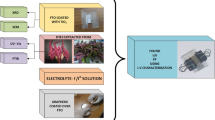Abstract
This study takes advantage of the natural plant dwarf morning glory. It may be able to use in solar photovoltaic technology. The experimental results indicated that the dwarf morning glory flower dye has an absorption peak of 657 nm. The manufactured dye-battery has be obvious, a maximum current of 4.7 × 10−3 (A/cm2) and a maximum voltage of 0.27 V and a conversion efficiency of 1.27 %. The yield of hydrogen generation can reach to 3.14 × 10−05 (l/s m2).



Similar content being viewed by others
References
Fujishima, A., Honda, K.: Electrochemical photolysis of water at a semiconductor electrode. Nature 238, 37–38 (1972)
Grätzel, M.: Applied physics: solar cells to dye for. Nature 421, 586–587 (2003)
Hanley, N., Shogren, J.F., White, B.: Environmental Economics in Theory and Practice. Macmillan, Basingstoke (1997)
Kay, A., Grätzel, M.: Photosensitization of titania solar cells with chlorophyll derivatives and related natural porphyrins. J. Phys. Chem. 97, 6272–6277 (1993)
Mantell, C., Rodriguez, M., de la Ossa, E.M.: Measurement of the diffusion coefficient of a model food dye (malvidin 3,5-diglucoside) in a high pressure CO2+ methanol system by the chromatographic peak-broadening technique. J. Supercrit. Fluids 25, 57–68 (2003)
O’Regan, B., Grätzel, M.: A low-cost, high-efficiency solar cell based on dye-sensitized colloidal TiO2 films. Nature 353(24), 737–740 (1991)
Pichot, F., Gregg, B.A.: The photovoltage-determining mechanism in dye-sensitized solar cells. J. Phys. Chem. B. 104, 6–10 (2000)
Saito, N., Toki, K., Morita, Y., Hoshino, A., Iida, S., Shigihara, A., Honda, T.: Acylated peonidin glycosides from duskish mutant flowers of Ipomoea nil. Phytochemistry 66, 1852–1860 (2005)
Serpone, N., Pelizzetti, E.: Photocatalysis: Fundamental and Applications. Wiley, New York (1983)
So, P.T.C., Dong, C.Y., Masters, B.R., Berland, K.M.: Two-photon excitation fluorescence microscopy. Annu. Rev. Biomed. Eng. 2, 399–429 (2000)
Su, Y.H., Lai, W.H., Teoh, L.G., Hon, M.H., Huang, J.L.: Layer-by-layer Au nanoparticles as a Schottky barrier in water-based dye-sensitized solar cell. Appl. Phys. A 88, 173–178 (2007)
Su, Y.H., Huang, S.H., Kung, P.Y., Shen, T.W., Wang, W.L.: Hydrogen generation of Cu2O nanoparticles/MnO–MnO2 nanorods heterojunction supported on sonochemical-assisted synthesized few-layer graphene in water-splitting photocathode. ACS Sustain. Chem. Eng. 3, 1965–1973 (2015)
Tennakone, K., Bandaranayake, P.K.M., Jayaweera, P.V.V., Konno, A., Kumara, G.R.R.A.: Dye-sensitized composite semiconductor nanostructures. Phys. E 14, 190–196 (2002)
Wang, P., Klein, C., Humphry-Baker, R., Zakeeruddin, S.M., Gratzel, M.: A high molar extinction coefficient sensitizer for stable dye-sensitized solar cells. J. Am. Chem. Soc. 127, 808–809 (2005)
Wang, P., Zadeeruddin, S.M., Comte, P., Charvet, R., Humphry-Baker, R., Gratzel, M.: Enhance the performance of dye-sensitized solar cells by Co-grafting amphiphilic sensitizer and hexadecylmalonic acid on TiO2 nanocrystals. J. Phys. Chem. B 107, 14336–14341 (2003)
Whitesides, G.M., Grzyboski, B.: Beyond molecules: self-assembly of mesoscopic and macroscopic components. Proc. Natl. Acad. Sci. 99, 4769–4774 (2002)
Wongcharee, K., Meeyoo, V., Chavadej, S.: Dye-sensitized solar cell using natural dyes extracted from rosella and blue pea flowers. Sol. Energy Mater. Sol. Cells 91, 566–571 (2007)
You, Y., Zhang, S., Wan, L., Xu, D.: Preparation of continuous TiO2 fibers by sol–gel method and its photocatalytic degradation on formaldehyde. Appl. Surf. Sci. 258, 3469–3474 (2012)
Zhou, H., Wu, L., Gao, Y., Ma, T.: Dye-sensitized solar cells using 20 natural dyes as sensitizers. J. Photochem. Photobiol. A 219, 188–194 (2011)
Acknowledgments
The authors gratefully acknowledge the financial support provided to this study by the National Science Council (NSC) of Taiwan under contract no. NSC 101-2221-E-151-015 and No. 102-2221-E-006-293-MY3.
Author information
Authors and Affiliations
Corresponding author
Additional information
This article is part of the Topical Collection on Micro/Nano Photonics for the International Year of Light 2015.
Guest Edited by Yen-Hsun Su, Lei Liu, Xinlong Xu and Zhenhua Ni.
Rights and permissions
About this article
Cite this article
Tu, SL., Chen, TH., Su, YH. et al. Optoelectronic properties of morning glory as dye on TiO2 thin film. Opt Quant Electron 48, 92 (2016). https://doi.org/10.1007/s11082-016-0391-7
Received:
Accepted:
Published:
DOI: https://doi.org/10.1007/s11082-016-0391-7




